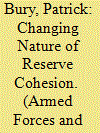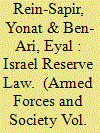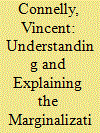|
|
|
Sort Order |
|
|
|
Items / Page
|
|
|
|
|
|
|
| Srl | Item |
| 1 |
ID:
165026


|
|
|
|
|
| Summary/Abstract |
For too long military cohesion scholars have focused on regular infantry forces. This article examines the impact of the Future Reserves 2020 (FR20) policy on cohesion, professionalism, and discipline among British reserve logisticians. In doing so, it makes three significant contributions to the cohesion literature. Firstly, addressing scholars’ almost exclusive focus on regular infantry, it presents the first academic study on cohesion in British reserve logistics forces. Secondly, in detailing how cohesion in these forces is based on interpersonal rather than professional bonds, it argues that the locus of cohesion and discipline in these forces is different to that recently identified in the regular professional infantry. Thirdly, the article argues that while FR20 is gradually changing many of British reserve norms, the organizational realities of reserve service continue to limit the policy's impact. The evidence presented may be theoretically applicable to other reserve and noncombat forces in future cohesion research.
|
|
|
|
|
|
|
|
|
|
|
|
|
|
|
|
| 2 |
ID:
183837


|
|
|
|
|
| Summary/Abstract |
This study examined the impact of perceived social support on mental health and psychosocial functioning in combat veterans after military deployment, including veterans with post-traumatic stress disorder (PTSD) and veterans with comorbid PTSD and alcohol use disorder. Veterans (n = 139; female = 23) completed self-report and clinician-administered measures of social support, mental and physical health, functional impairment, and quality of life. The cohort was divided into high, medium, and low perceived social support based on averages of the total score from the Multidimensional Scale of Perceived Social Support. Relative to the low perceived social support group, the high perceived social support group reported fewer symptoms of PTSD, anxiety, and depression. The high perceived social support group also reported a more diverse and embedded social network, less disability, and better quality of life. Of note, the high and low perceived social support groups did not differ on age, gender, education, race ethnicity, or combat trauma exposure. These findings highlight that perceived social support may play an important role in the treatment of postwar veterans as they transition back to civilian life.
|
|
|
|
|
|
|
|
|
|
|
|
|
|
|
|
| 3 |
ID:
181158


|
|
|
|
|
| Summary/Abstract |
Enacted in 2008, 60 years after Israel Defense Forces was established, the Israeli Reserves Law is a striking expression of the decline of military autonomy in a democratic country. While not aimed at reducing the military’s discretion in regard to the training, deployment, and compensation for reservists, the formal enactment of the Law in effect did so. The legislative process was preceded by a crisis between reservists and the military and was led by several reservists’ organizations who tried to improve the standing and resources allocated to the reserve forces. The article analyzes the impact of these organizations and the coalitions they created with politicians serving in the national parliament, the Knesset. By choosing the legislative option to improve the conditions of service for reservists, they de facto reduced military autonomy since the new Law mandated supervision and monitoring (by civilian institutions) of the service of reservists and extended into the core area of military action, the operational use of force. Thus, the actions of reservists’ organizations turned a bilateral tie between the military and its (reserve) soldiers into a trilateral one, comprising the military, reserve soldiers, and state institutions.
|
|
|
|
|
|
|
|
|
|
|
|
|
|
|
|
| 4 |
ID:
181154


|
|
|
|
|
| Summary/Abstract |
This article reexamines and develops the analytical metaphor of “Reserve Soldiers as Transmigrants” in three directions. First, we advance the notion of transmigration by linking it to the explicit and implicit “contracts” or agreements struck between the military and individuals and groups within and outside of it. Second, we show that the “management” model of reserve forces is not just an administrative matter but that “negotiating” with reservists involves wider issues that include managing identity, commitment, and the meaning attached to military service. Third, we examine the institutional and political meaning of the reserves at the macro sociological level. The juxtaposition and interplay of two models—transmigration and multiple contracts—allows us to introduce structural elements into the movement of soldiers between the military and civilian society, and add a dynamic dimension to the contents of the implicit contracts that organize reservists’ relations with the state and military.
|
|
|
|
|
|
|
|
|
|
|
|
|
|
|
|
| 5 |
ID:
181156


|
|
|
|
|
| Summary/Abstract |
Recent changes in the British Army mean part-time reservists and full-time regulars need to become better integrated. However, there has been a long history of workplace tensions between the full-time and part-time elements in the British Army. This mirrors those found in many civilian workplaces. Focus group data with 105 full-time regular British Army soldiers confirmed that time and emotional commitment are strongly linked in a full-time professional workplace that has strong, definite, and enduring boundaries. This, alongside demands for conformity and stratification by rank explained the high risk of marginalization of part-time reservists. The legitimacy of part-time reservists, especially in the combat arms, was often challenged. Using this explanatory framework, some implications and practical ways that tensions may be reduced between full-time and part-time members of the British Army, and other armed forces facing similar tensions, were highlighted.
|
|
|
|
|
|
|
|
|
|
|
|
|
|
|
|
|
|
|
|
|